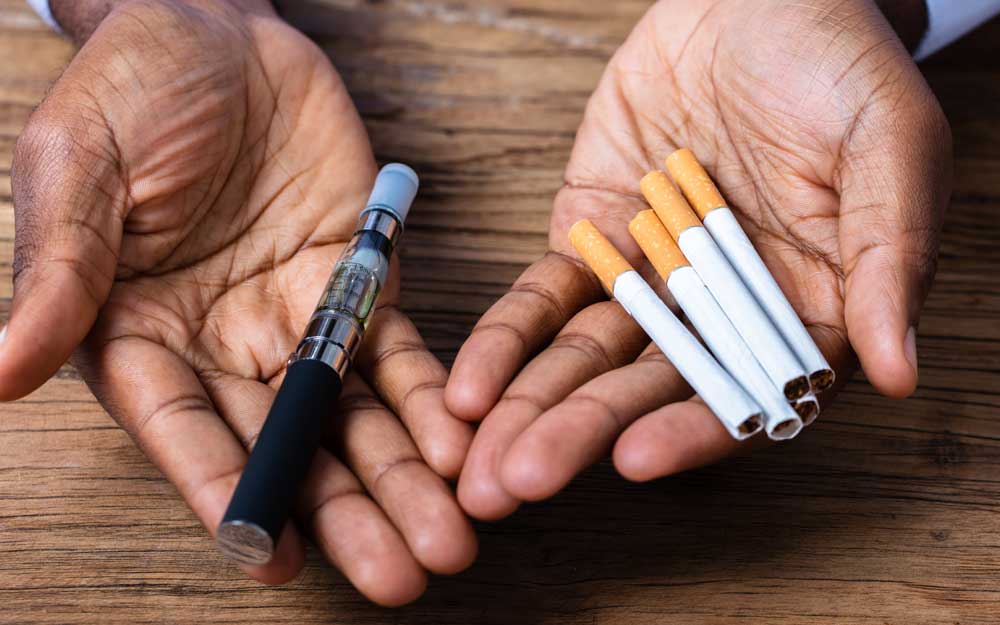As vaping gains more popularity, especially among young people, misconceptions and questions are rampant. Rogers’ Dr. Michelle Maloney, executive director of addiction services, answers some of the most common questions surrounding vaping and e-cigarettes.
What is vaping?
The term “vaping” refers to a substance being heated to the point of releasing vapor, but not combusting. Vaping devices include a mouthpiece, battery, cartridge containing e-liquid/vape juices, and a heating component. The device heats the e-liquid (also called e-juice or vape juice) to create an aerosol that is inhaled into the lungs and then exhaled.
When is vaping legal? Illegal?
In general, vaping falls under the same regulations as smoking laws so selling vapes and vaping cartridges to minors is illegal. E-liquids containing THC, the main psychoactive component in marijuana, are illegal for those under 21 and for anyone who lives in a state where marijuana is illegal.
What is in e-liquids/vape juice?
It’s important to note that at this time the FDA has not evaluated any of the e-liquids on the market and does not regulate these products. The FDA requires that vape manufacturers disclose ingredients in e-liquids, but not the harmful carcinogens in the heated vapor. The FDA is currently considering significant restrictions on flavored e-liquids.
In a liquid form, the most common e-liquid ingredients are nicotine and flavorings. The flavorings themselves often include propylene glycol and glycerin, ingredients generally viewed as safe when used in food, though the long-term effects of inhaling these substances is unknown. Flavorings also may contain diacetyl, which is most commonly used to create the buttery flavor in popcorn. When inhaled, this substance is linked to obstructive lung disease and a condition known as “popcorn lung,” which damages the lungs’ airways and causes shortness of breath and dry coughing.
When the e-liquid is heated to create a vapor, toxic chemicals are formed, including likely carcinogens formaldehyde and acetaldehyde, as well as acrolein, which can damage the lungs and contribute to heart disease. Additionally, small particles of toxic metals like tin, nickel, cadmium, lead, and mercury have been discovered in the aerosol given off by vaping.
Is vaping ever safe?
In short, no. No smoking, nicotine, or tobacco product is completely safe. Until recently, the perception of vaping has been that it is better than smoking. It’s important to remember that “less harmful” does not mean something is safe.
Does vaping always involve nicotine?
The e-liquid used for vaping typically contains either nicotine or THC.
Is vaping addictive?
Vaping cartridges contain nicotine or THC, both of which are addictive substances.
Are there any advantages of vaping compared to smoking traditional cigarettes?
In general, there are no smoking or tobacco products that are completely safe. The CDC states that “E-cigarettes have the potential to benefit adult smokers who are not pregnant if used as a complete substitute for regular cigarettes and other smoked tobacco products.” Importantly, the CDC recommends that if an adult has used e-cigarettes to quit smoking, the individual should not return to smoking traditional cigarettes.
Does vaping help people quit smoking?
There are numerous advertisements indicating that vaping will help you stop smoking. Despite this, according to the CDC there is no scientific research to support the effectiveness of this claim.
What is the biggest concern with vaping?
One of the main concerns with vaping is the risk of lung injury and death. The CDC’s latest release states that there have been over 500 cases of lung injury and seven deaths as the result of vaping. Not knowing why these injuries and deaths have occurred is a huge concern because without that knowledge many misconceptions and uncertainties around vaping have continued.
Another major concern is the adolescent epidemic associated with vaping. Data from Monitoring the Future shows that nearly 21% of high school seniors vaped in 2018, up from 11% in 2017. This same study also shows a significant increase in vaping among middle and even elementary school students. The FDA has also declared adolescent vaping an epidemic.
Is second-hand smoke from vaping dangerous?
According to the American Lung Association, all second-hand smoke can pose a potential health risk, including the “vapor” produced by e-cigarettes.


